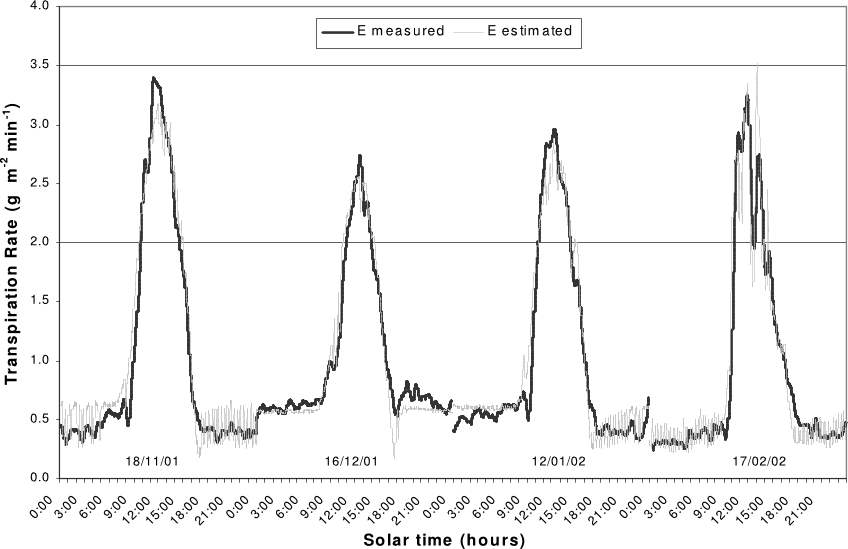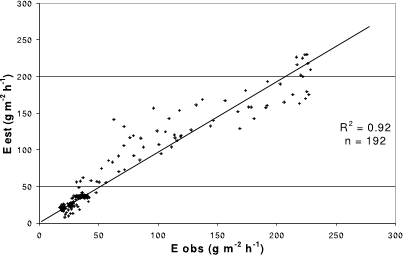




Did you find this useful? Give us your feedback










18 citations
13 citations
...[19], the estimation of stem LA in cut roses of the cv....
[...]
...[19], although a lower number of observations were used....
[...]
...[19] study, the model developed in our study considered successive measurements of the LA of all erect stems of one plant through its crop cycle, enabling accommodation of a range of different development stages, which increases its potential applicability....
[...]
...The limitations also extend to the architecture of the plant, with some models being developed using material exclusively from erect stems, disregarding samples resulting from the bending of weak stems of the plant [1,19]....
[...]
...Several models are currently available for rose crop to determine the area of individual leaves [1,17,18], leaflets [5], and stems [19] using allometric measures such as the length and width of leaves or leaflets, the number of leaflets, or the height of the stem....
[...]
10 citations
...As far as water uptake is concerned, it has been mainly related to radiation, to VPD and to leaf area (Baille et al., 1994; Medrano, 1999; Suay et al., 2003), but also to air temperature (Medrano, 1999) and to nutrient solution temperature (Chapter 4....
[...]
...In different studies (Baille et al., 1994; Medrano, 1999; Suay et al., 2003), water uptake models have been based in Penman-Monteith equation (Monteith and Unsworth, 2007) and have been related to radiation, to VPD and to leaf area....
[...]
7 citations
1 citations
4,087 citations
296 citations
...The radiation extinction coefficient (k) has been considered constant throughout the period and equal to 0.64 (Stanghellini, 1987)....
[...]
...A simplified version (Stanghellini, 1987; Boulard and Jemaa, 1993; Baille et al., 1994a; Medrano, 1999) that takes into account both, solar radiation and air saturation deficit as variables could be very useful for the implementation of irrigation algorithms in a soilless culture system....
[...]
175 citations
...Estimation of E when solar radiation is very low or cero is improved if the saturation deficit of air is considered, particularly when required time intervals are short (Jolliet and Bailey, 1992; González, 1995)....
[...]
...Jolliet and Bailey (1992) report on some 22% the night transpiration fraction of the 24 hours period, for young tomato plants, under heated greenhouse, and Medrano (1999) obtained 10 to 20% for cucumber in Spain, in a cold greenhouse in Autumn....
[...]
103 citations
83 citations
Heating is supplied for a minimum of 16 ºC, by means of air forced aerotherms, and humidity is kept at 50 % minimum with a high pressure fog system.
It has also been found that only 11 shoots are needed to estimate the leaf area ofthe flowering shoots, with an error less than 5 %, but usually some more have been used.
In order to implement a real-time irrigation management, short time (15 seconds)estimations of crop transpiration have been used.
For instance, on a sunny day, the quantity of supplied water has been about 1000 litres versus 2280 lsupplied by means of the time scheduling policy.
All plants are grown following the local standard commercial technics, using the stem bending technique and all-year-round production.
VPDLAIGeE LAIk ∗∗Β+∗−∗Α= ∗−1the flowering shoots part has been estimated on a weekly basis, as a linear function of the length of the shoots, entered as input to the transpiration model.
Estimations made by the model have been very acceptable, at the practical level, for irrigation control, in soilless growing systems that have a high level of fragility due to the very low buffer capacity for water and minerals.
Results and discussionTranspiration Flux in Relation to the Microclimate When transpiration (E) is considered in relation to values of outside solar radiation(figure 1) between 100 and 400 wm -2 , a positive correlation is observed, with lower scattering than in the range of 400 to 600 wm -2 .